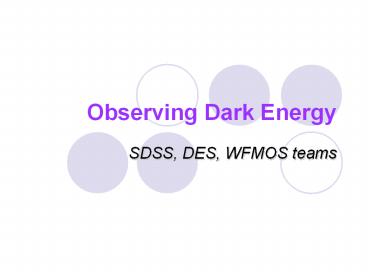Observing Dark Energy - PowerPoint PPT Presentation
1 / 21
Title:
Observing Dark Energy
Description:
No compelling theory, must be observational driven. We can make ... Blake et al. 2006, Padmanabhan et al. 2006. Cosmological Constraints. Sullivan et al. (2003) ... – PowerPoint PPT presentation
Number of Views:24
Avg rating:3.0/5.0
Title: Observing Dark Energy
1
Observing Dark Energy
- SDSS, DES, WFMOS teams
2
Understanding Dark Energy
- We can make progress on questions
- Is DE just a cosmological constant (w(z)-1)?
- (Make better observations and push to higher z)
- Is DE a new form of matter (with negative
effective pressure) or a breakdown of GR? - (Study DE using different probes)
- But there are only two broad avenues
- Geometrical tests (SN, BAO)
- Growth of structure (ISW)
No compelling theory, must be observational driven
3
Massive Surveys
Need large surveys of the Universe to measure DE
accurately
SDSS AS2 ISW SDSS SN Survey
(Smiths talk) Baryon Acoustic Oscillations
(BAO) Dark Energy Survey (DES) The power of
photo-zs (Lahavs talk) WFMOS by
Gemini/Subaru The power of spectroscopy
4
SDSSwww.sdss.org
SDSSwww.sdss.org.uk/dr5
DR5 Million spectra, 8000 sq degs Extension
(2005-2008) Legacy, SNe, Galaxy
5
Integrated Sachs-Wolfe Effect
Dark Energy effects the rate of growth of
structure in Universe
- Poisson equation with dark energy
- In a flat, matter-dominated universe (CMB tells
us this), then density fluctuations grow as - Therefore, curvature or DE gives a change in the
gravitational potential
6
Experimental Set-up
Nolta et al, Boughn Crittenden, Myers et al,
Afshordi et al, Fosalba et al., Gaztanaga et al.,
Rassat et al.
7
WMAP-SDSS Correlation
No signal in a flat, matter-dominated Universe
WMAP W band
Luminous Red Galaxies (LRGs)
8
ISW Detected
Update of the Scranton et al. (2003) paper
- 6300 sq degrees
- Achromatic
- 5? detection
9
Giannantonio et al. (2006)
Cross-correlation of WMAP3 and SDSS quasars
WMAP3 best fit
0.075lt?mlt0.45 -1.15ltwlt-0.76
Detection of DE at zgt1
10
Evolution of DE
Consistent with w-1 Rules out models
?D?(z1.5) gt 0.5
11
Modified Gravity
Song et al. (2006)
12
DESVISTA
- Give photo-zs to z2 with ? lt 0.1
- ISW will be competitive with SNAP for
non-constant w (Pogosian et al. 2005)
13
SDSS SN Survey
- Use the SDSS 2.5m telescope
- September 1 - November 30 of 2005-2007
- Scan 300 square degrees of the sky every 2 days
- Stripe82 (UKIDSS data)
- WHT/NTT leading spectroscopic follow-up (Smith
talk)
14
(No Transcript)
15
DES SN Survey
SN surveys are now systematics limited Focus on
elliptical hosts as less dust and no SNII DES
will survey 9deg2 to z1 detecting 300
ellipticals Ias in 5 years Target clusters
(boost of a few)
Sullivan et al. (2003)
16
Baryon Acoustic Oscillations
?m0.24 best fit WMAP model
Miller et al. 2001, Percival et al. 2001,
Tegmark et al. 2001, Cole et al. 2005,
Eisenstein et al. 2005, Hutsei 2006, Blake et
al. 2006, Padmanabhan et al. 2006
WMAP3
Percival et al. 2006
SDSS DR5 520k galaxies
17
Cosmological Constraints
Standard ruler (flat,h0.73,?b0.17)
Percival et al. (2006)
h0.720.08 HST ?m0.2560.049-0.029
99.74 detection
Best fit ?m0.26
Sullivan et al. (2003)
?m0.275h WMAP3 ?m0.2560.029-0.024
?mh2 WMAP3 ?m0.2560.019-0.023
18
WFMOS
- Proposed MOS on Subaru via an international
collaboration of Gemini and Japanese astronomers - 1.5deg FOV with 4500 fibres feeding 10 low-res
spectrographs and 1 high-res spectrograph - 20000 spectra a night (2dfGRS at z1 in 10
nights) - DE science, Galactic archeology, galaxy formation
studies and lots of ancillary science from
database
19
WFMOS Surveys
- Parkinson et al. (2007)
- Emission-line galaxies
- 5600 deg2 at z1.1 (dz0.3)
- 150 deg2 at z3.15 (dz0.2)
- FoM an order of magnitude larger than SDSS
(dw4) - Optimum is broadly peaked and insensitive to
other surveys - Now investigating curvature and other w(z) models
(Clarkson et al. 2007)
Optimize instrument parameters
20
After SDSSII
Baryon Oscillation Spectroscopic Survey (BOSS)
- Measure distance to 1 at z0.35 and z0.6
- 10000 deg2 with 1.5m LRGs to z0.8 (median
z 0.5) - 100k quasars as well
- Starting 2009
- 7 times more volume
2SLAQ
21
Conclusions
- ISW has measured density of DE at zgt1 looks like
a cosmological constant - SDSS SN Survey will deliver gt500 Ias this year.
SN surveys are now systematics dominated (DES
will exploit Ias in elliptical galaxies) - SDSS BAO measures are robust and deliver 10
measurements on cosmological parameters - WFMOS and AS2 will move BAO to 1 level
- Strong degeneracy with curvature need many
distance scale measures as function of redshift
22
2057 (April 1st 2007)































